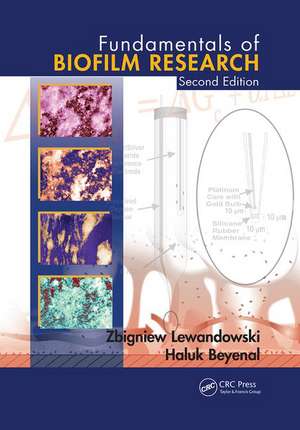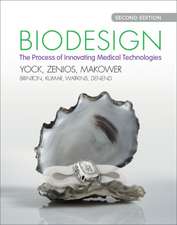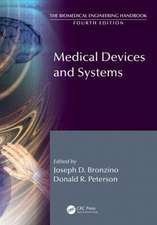Fundamentals of Biofilm Research
Autor Zbigniew Lewandowski, Haluk Beyenalen Limba Engleză Paperback – 31 mar 2017
Retaining the goals of the first edition, this second edition serves as:
- A compendium of knowledge about biofilms and biofilm processes
- A set of instructions for designing and conducting biofilm experiments
- A set of instructions for making and using various tools useful in biofilm research
- A set of computational procedures useful in interpreting results of biofilm research
- A set of instructions for using the model of stratified biofilms for data interpretation, analysis, and biofilm activity prediction
| Toate formatele și edițiile | Preț | Express |
|---|---|---|
| Paperback (1) | 702.48 lei 6-8 săpt. | |
| CRC Press – 31 mar 2017 | 702.48 lei 6-8 săpt. | |
| Hardback (1) | 1421.16 lei 6-8 săpt. | |
| CRC Press – 16 dec 2013 | 1421.16 lei 6-8 săpt. |
Preț: 702.48 lei
Preț vechi: 771.96 lei
-9% Nou
Puncte Express: 1054
Preț estimativ în valută:
134.42€ • 143.74$ • 112.08£
134.42€ • 143.74$ • 112.08£
Carte tipărită la comandă
Livrare economică 17 aprilie-01 mai
Preluare comenzi: 021 569.72.76
Specificații
ISBN-13: 9781138074378
ISBN-10: 1138074373
Pagini: 672
Ilustrații: 351; 127 Tables, black and white; 16 Illustrations, color; 429 Illustrations, black and white
Dimensiuni: 178 x 254 x 35 mm
Greutate: 1.24 kg
Ediția:2 New edition
Editura: CRC Press
Colecția CRC Press
ISBN-10: 1138074373
Pagini: 672
Ilustrații: 351; 127 Tables, black and white; 16 Illustrations, color; 429 Illustrations, black and white
Dimensiuni: 178 x 254 x 35 mm
Greutate: 1.24 kg
Ediția:2 New edition
Editura: CRC Press
Colecția CRC Press
Public țintă
Academic and Professional Practice & DevelopmentCuprins
Introduction to biofilms and to biofilm research. Imaging and characterizing biofilm components. Laboratory biofilm reactors and their applications. Sensors useful in biofilm research. Microsensors: Construction, instrumentation, and calibration. Quantifying biofilm structure. Biofilms on metals and other electrically conductive surfaces. Interpreting results of biofilm studies using the model of stratified biofilms. Protocols and procedures.
Recenzii
"One of the biggest advantages is the detailed background of experimental biofilm approaches. The view from engineering and chemistry on biofilms is a contribution to the interdisciplinary character of biofilm research."
—Hans-Curt Flemming, University of Duisburg-Essen
"This sounds like a "hands-on" manual for someone who really wants to get stuck in and set up to study biofilms. The highly detailed descriptions and protocols allude to this being a comprehensive text book as well as manual on biofilms. I was impressed by the inclusion of mathematical modeling as this can provide new hypotheses to explore and test through laboratory experimentation."
—Dr Bambos M. Charalambous, FBS, University College London
"This book provides comprehensive coverage of a variety of methods for the study of biofilms. The book includes a lot of practical "how~to" information for designing and conducting biofilm experiments, including data analysis and computer modeling. This book will be useful for novices as well as experienced biofilm researchers."
—Garth James, Center for Biofilm Engineering, Montana State University
Praise for the Previous Edition
"True to its word, this book describes the fundamentals of biofilm research from a bioengineering perspective in an easy-to-read and straightforward manner. This is an interesting, logical and well-written book . . . this is a comprehensive and well rounded book which is complementary to other literature in this area."
—Kathryn Whitehead, Manchester Metropolitan University, Microbiology Today, Nov 2008
"The authors have done an admirable job of satisfying all the criteria described in the preface. I highly recommend that microbial bioengineering students at any level obtain a copy of this book. While geared primarily towards the engineer, it is also a nice browse for biologists interested in the mathematics behind ‘the voodoo that those engineers do’. Therefore, this book is excellent for laboratories wishing to perform biofilm research from many applied perspectives (such as wastewater treatment and biomanufacturing), and it will be especially useful for the less experienced researcher in those labs. I can further recommend it as a nice addition for libraries at research universities as well as for industry resource libraries."
—Robert J. Palmer, NIDCR, NIH, Journal of Microbiological Methods, 71 (2007)
"Z. Lewandowski and H. Beyenal are uniquely qualified to write this book given their 20 years experience as biofilm researchers who have pioneered many of the techniques described in the book. However, Fundamentals of Biofilm Research is more than the collected published works of Z. Lewandowski and H. Beyenal. The book is unique in that it provides a thorough treatment of the subject with both overview and precise methodology so that the reader can appreciate the significance of clearly defined parameters. The authors also demonstrate the manner in which hypothesis driven research has advanced our understanding of biofilms. A detailed table of contents, index and crossreferences within the text make this book an easily accessible resource. In some chapters, citations within the text are listed separately and in others, the cited references are mixed with suggested readings. In all cases, the authors have supplied an extensive list of relevant literature divided by topic area. I enthusiastically recommend Fundamentals of Biofilm Research to both new and experienced biofilm researchers."
—Dr. Brenda Little, in Biofouling: The Journal of Bioadhesion and Biofilm Research
"After a very straightforward introduction, many technical aspects of biofilms such as imaging of biofilms, operation of laboratory biofilm reactors, sensors, and – as one of the big strengths – quantification of biofilm structure are presented in great and valuable detail. This is a "how-to-do" book for practical biofilm research."
––Hans-Curt Flemming, University of Duisburg-Essen, Germany
—Hans-Curt Flemming, University of Duisburg-Essen
"This sounds like a "hands-on" manual for someone who really wants to get stuck in and set up to study biofilms. The highly detailed descriptions and protocols allude to this being a comprehensive text book as well as manual on biofilms. I was impressed by the inclusion of mathematical modeling as this can provide new hypotheses to explore and test through laboratory experimentation."
—Dr Bambos M. Charalambous, FBS, University College London
"This book provides comprehensive coverage of a variety of methods for the study of biofilms. The book includes a lot of practical "how~to" information for designing and conducting biofilm experiments, including data analysis and computer modeling. This book will be useful for novices as well as experienced biofilm researchers."
—Garth James, Center for Biofilm Engineering, Montana State University
Praise for the Previous Edition
"True to its word, this book describes the fundamentals of biofilm research from a bioengineering perspective in an easy-to-read and straightforward manner. This is an interesting, logical and well-written book . . . this is a comprehensive and well rounded book which is complementary to other literature in this area."
—Kathryn Whitehead, Manchester Metropolitan University, Microbiology Today, Nov 2008
"The authors have done an admirable job of satisfying all the criteria described in the preface. I highly recommend that microbial bioengineering students at any level obtain a copy of this book. While geared primarily towards the engineer, it is also a nice browse for biologists interested in the mathematics behind ‘the voodoo that those engineers do’. Therefore, this book is excellent for laboratories wishing to perform biofilm research from many applied perspectives (such as wastewater treatment and biomanufacturing), and it will be especially useful for the less experienced researcher in those labs. I can further recommend it as a nice addition for libraries at research universities as well as for industry resource libraries."
—Robert J. Palmer, NIDCR, NIH, Journal of Microbiological Methods, 71 (2007)
"Z. Lewandowski and H. Beyenal are uniquely qualified to write this book given their 20 years experience as biofilm researchers who have pioneered many of the techniques described in the book. However, Fundamentals of Biofilm Research is more than the collected published works of Z. Lewandowski and H. Beyenal. The book is unique in that it provides a thorough treatment of the subject with both overview and precise methodology so that the reader can appreciate the significance of clearly defined parameters. The authors also demonstrate the manner in which hypothesis driven research has advanced our understanding of biofilms. A detailed table of contents, index and crossreferences within the text make this book an easily accessible resource. In some chapters, citations within the text are listed separately and in others, the cited references are mixed with suggested readings. In all cases, the authors have supplied an extensive list of relevant literature divided by topic area. I enthusiastically recommend Fundamentals of Biofilm Research to both new and experienced biofilm researchers."
—Dr. Brenda Little, in Biofouling: The Journal of Bioadhesion and Biofilm Research
"After a very straightforward introduction, many technical aspects of biofilms such as imaging of biofilms, operation of laboratory biofilm reactors, sensors, and – as one of the big strengths – quantification of biofilm structure are presented in great and valuable detail. This is a "how-to-do" book for practical biofilm research."
––Hans-Curt Flemming, University of Duisburg-Essen, Germany
Notă biografică
Zbigniew Lewandowski, Haluk Beyenal
Descriere
This second edition is a substantial revision of a well-regarded book in biofilm research. Biofilms have taken on added importance in the past several years due to concerns regarding microbial contamination as well as biofilms in water distribution systems and hospital/medical environments. The book includes updates in every chapter and adds three new chapters, namely: Optical Imaging of Biofilms, Biofilms and Microbially Influenced Corrosion, and Biofilms and Microbial Fuel Cells. Another key feature is the incorporation of energy conversion into a number of relevant chapters.
















